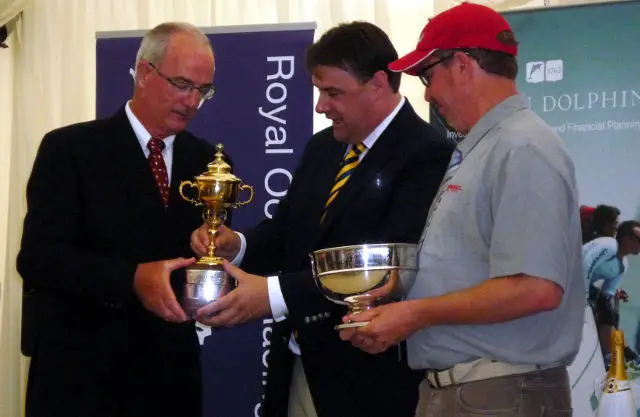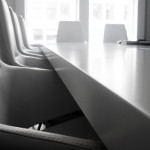Thanks to Suzanne and Alan for this latest sailing report from Cowes. Ed
Stuart Childerley, former Etchells World Champion, led the Race Committee who worked hard to set a fair, but challenging course. Boats were sent west out of the Solent, passing the Needles Fairway buoy then down to a ‘virtual mark’ 26 miles northeast of the Cherbourg peninsula, before returning north to the New Grounds Buoy off the Nab Tower, then on to the Bembridge Ledge buoy and leaving No Man’s Land Fort to port before the finish line south of Gosport’s Gilkicker Point.
During the day the race had not been overly tactical, but as darkness fell it became so. Prior to leaving Cowes, David Aisher on board his J/109 Yeoman of Wight in GBR Blue was keeping his fingers crossed that the wind would shut off later in the evening rather than earlier.
“If it shuts off when it says, then everyone should be home. But if it shuts off early I think the big boats will get in and the little boat will be stuck out and struggling to get in late morning (next day). We’ll just have to sail faster!”
At 17:45 BST Yeoman of Wight was lying second overall.
Shorter race than anticipated
Eventually stronger winds and reaching conditions resulted in a shorter than anticipated offshore race that allowed crews to sleep in their own beds rather than spending a night at sea with most boats finishing by midnight.
Wind was further west and stronger than forecast and this resulted in a fast reach down to the ‘virtual mark’ with boats such as the Ker 40s and the brand new French Archambault A 13, Teasing Machine, relishing the conditions.
“We had 20 knots – a good five knots more than forecast,” recounted Nick Cherry, one of the two ‘pros’ on Robert Lutener’s Ker 40, Cutting Edge, sailing in GBR Red. However, as forecast, the wind did drop and veer into the north as the boats sailed back towards the Nab Tower, but it never disappeared altogether and pre-race fears of a night spent off Bembridge proved unfounded.
Day four
Following this long race there was a few hours rest before the teams set off again but day four was one Principal Race Officer Stuart Childerley and his team would prefer to forget. With little wind shifting and holes in the wind attempts were made to race with start lines changed, but to no avail.
There followed a long wait for the boats in the Solent but eventually racing was halted for the day.
In contrast to the frustration of the previous day’s two unfinished races, three inshore races were successfully held on Thursday bringing the Brewin Dolphin Commodores’ Cup back on schedule.
There was a start line off Osborne Bay for the first windward-leeward race which was sailed in a light northeasterly. The second race was started in the same northeasterly wind, but saw a substantial right shift on the first upwind leg, so it was the turn of GBR Scotland’s big boat, James McGarry’s Swan 45 Eala of Rhu to make her mark.
At the opening reception a number of Scots were proud to wear their kilts in a range of tartans and the crew on Eala of Rhu explained how the boat was named. Eala in Gaelic is swan and as the boat is Swan 45 someone did their research. Rhu is in Argyll and now, a base for yachting, it derives its name from the Gaelic meaning point.
Eala of Rhu went on to win this race by more than two minutes from Michael Boyd and Niall Dowling’s Grand Soleil 43, Quokka 8, sailing in the Irish team.
To make up for the disappointment of the previous day and after some delays due to the arrival of ships in the Solent and wind shifts, plus three general recalls, the third race of the day finally got off late in the afternoon, once a southeasterly breeze had established.
Teams were worried about the Round the Island Race on Friday because of the lack of wind on some of the other days. Perhaps some remembered the long day of the JPMAM Round the Island Race back in June. However, the Race Committee stuck to the schedule and sent the nine three-boat teams on a course anti-clockwise around the Isle of Wight with the start at 09:30 BST from the Royal Yacht Squadron line.
As they rounded St Catherine’s Point they sailed into no wind and a building adverse tide. Several boats touched sand or worse, rocks, the worst affected being the star of the Irish team, Anthony O’Leary’s Ker 39 Antix, which upon arriving back in Cowes had to be hauled out of the water for repairs.
Whilst the big boats ‘parked –up’ near Ventnor the smaller boats caught up. The star performer was David Aisher’s J/109 Yeoman of Wight. Having been one of the southerly losers coming down the Solent, and then seeing the leaders disappear on the leg to St Catherine’s, David Aisher said:
“When we went around the corner at St Catherine’s, it was ‘oh, hello!’ – everyone had parked up. Then it was a case of finding the gusts. We clouted a rock, but not badly because we were only doing 0.5 knots through the water, but Antix hit the bricks hard.”
The smallest boats topped the results
With the course shortened, finishing at Bembridge Ledge, there wasn’t enough track left for the big boats to recover and the smallest boats topped the results.
Ireland had retained the majority of their points lead and went into the final days race, a double points scoring race, with a comfortable 94.5 margin over the French.
First across the line in an actual time of 8:19:48 was Catapult representing Ireland but the handicap system demoted her to 17th place. Conversely, Yeoman of Wight finished in a corrected time of 9:36:59 stealing victory for GBR Blue.
Ireland bounced back
After a disappointing result in the Round the Isle of Wight race, Ireland bounced back for the last around the cans course in the central Solent with the Irish boats claiming three of the top four places on corrected time.
Antix put in a particularly powerful performance following the damage she sustained in the previous race. This damage bent the aft end of her keel and split the bottom 1ft of her rudder and her shore crew worked through the night to ensure she was ready for racing and ready for racing she was.
So it was Ireland, making a comeback after winning in 2010,that won the Brewin Dolphin Commodores’ Cup. This year they returned with a vengeance finishing the regatta on 268 points, with an unprecedented lead of 173.5 points. Catapult, owned by American Mark Glimcher was the best performing individual boat.
Full Result:
Ireland 268, France Red 441.5, France Blue 446.5, GBR Red 448, France Green 456.5, Scotland 457, GBR White 526, GBR Blue 557.5 and France White 613.
Prizes were presented by Stephen Ford, Head of Investment Management at Brewin Dolphin. Stephen had said at the start of the regatta that this was the second of the three editions of the Commodores’ Cup with Brewin Dolphin as headline sponsor.
He told us that there were three reasons for being sponsors,
“It was a great competition but it was amateur in essence, we (Brewin Dolphin) like it and so do our clients.”
At the prizegiving Stephen said that their clients had enjoyed the week but joked that it cost a fortune.
As well as sponsoring this event Brewin Dolphin, founded in 1762, sponsored one of the show gardens, for a sixth year, at Chelsea Flower Show.
At the prizegiving held at the RYS guests were welcomed by Eddie Warden-Owen CEO of RORC and the Admiral of the RORC Andrew McIrvine referred to the regatta as the most amazing event but that the weather was more taxing.
Anthony O’Leary and the other skippers /owners of the Irish boats received The Commodores’ Cup together with other prizes they had won during the week so it was a case of ‘Irish Eyes Are Smiling.’ Although used for this RORC event The Commodores’ Cup trophy belongs to the Island Sailing Club and is generously made available to the RORC by the Island Sailing Club. Included in the guest list for the prizegiving were the Commodore of the ISC John Dudley and his wife Jenny.
The next Brewin Dolphin Commodores’ Cup is to be raced in 2016.




